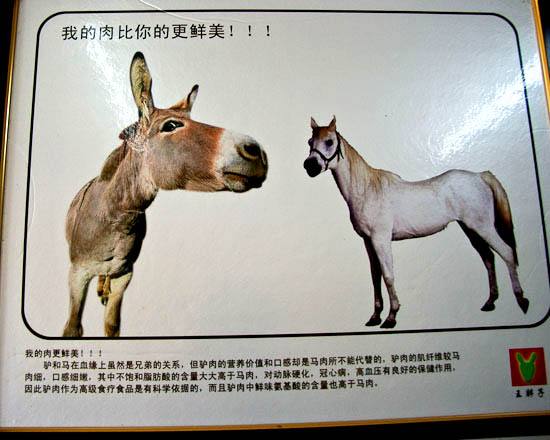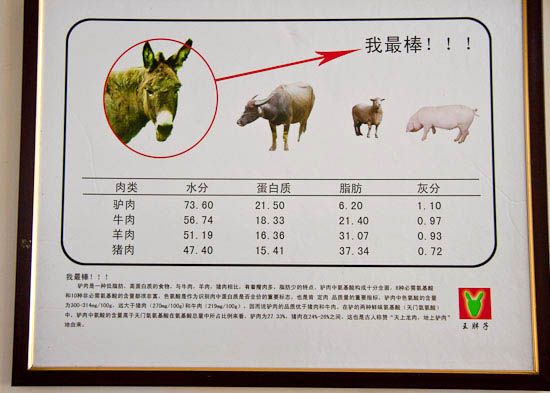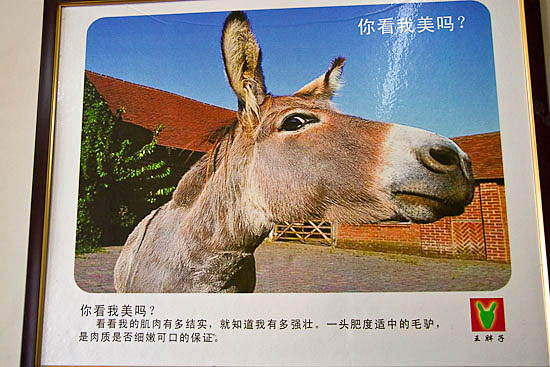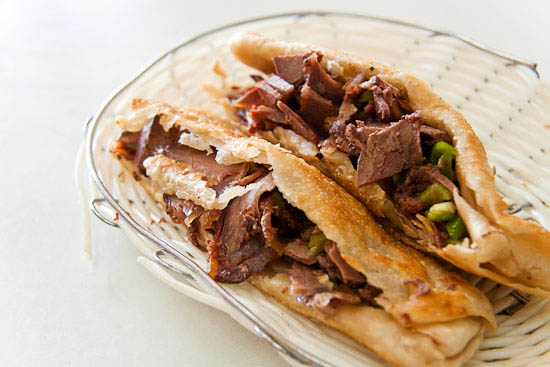There’s a strange competition going on. Perhaps you had not realized, but all along – at least according to Fattie Wang’s Donkey Buns (王胖子驴肉火烧) – animals have been vying for the honor of being…eaten.
Yes, for if you believe the posters decorating this little snack stall, nothing would please Mr. Donkey more than if you, illustrious diner, chose him over those common creatures, the cow or the pig.
Fattie Wang is partisan. “I’m the best!” and “Choose me!” proclaims Mr. Donkey from the walls. In case you are not swayed by his handsome mug (“Don’t you think I’m pretty?”), there’s also a convenient chart for you to see Donkey’s distinct advantages over his peers.
To wit, donkey meat is higher in water and proteins and lower in fat compared to beef, mutton, and pork. Other pictures boast of the donkey’s natural grazing lifestyle in remote grasslands and claim that the meat has aphrodisiac powers. Hence, the conclusion: “In heaven there is dragon meat, and on earth there is donkey meat.”
It’s rather hard for us to judge the accuracy of this description, having never tasted dragon. Donkey, though, is tender and juicy, and not at all tough (as I expected). There are no particularly asinine flavors; it’s rather like beef. Indeed, without knowing what it was, you might easily think it was beef.
This may come as a blow to people who grew up on Eeyore, but no one would blink an eye at the thought of eating donkey in China, though it’s not an “everyday” meat like pork or beef. Hunan is famous for its spicy “Donkey of Hunan” (湘之驴 xiang zi lü) dish, full of chili peppers and served over a small flame, while nearby Jiangxi province does a few things with donkey as well. But much more popular in Beijing is Hebei province’s lürou huoshao (驴肉火烧), braised donkey meat served in a flatbread bun (huoshao is another word for shaobing).
(Fattie) Wang Pangzi is widely thought to make some of Beijing’s best lürou huoshao. Tender chunks of braised meat are chopped with green peppers (jianjiao 尖椒) and cilantro before being stuffed inside a rectangular crispy flatbread. To ensure maximum juiciness, the meat is doused with a few spoonfuls of the braising broth.
A regular bun costs RMB 5, and a bun with leaner cuts is RMB 6. It’s delicious, a snack-sized symphony of flaky bun, fall-apart-tender meat, and fresh greens. But it still doesn’t come anwhere close to Long Xing Sheng‘s niurou huoshao (braised beef sandwiched in a sesame shaobing), which only costs RMB 4 and is one of the most amazing things you can eat in Beijing. Enough said.
There are five locations of Fattie Wang’s; the best is supposed to be the Gulou location but we went to the Dongsi shop:Wangpangzi Lürou Huoshao [map]
92 Dongsi Beidajie (the door is actually on Dongsi Shisantiao)
Dongcheng District
Tel: 1312 156 5643
王胖子驴肉火烧
东城区东四北大街92号









































Hee, hee, hee!! This is too funny. It definately puts a twist on knowing where your food comes from!
hey i am a design editor of BALLER MAGAZINE,and i was interested in publishing a few of your DONKEY meat recipe in our magazine, which fits in our meat section of this months issue.would you be able to provide us some high resolution pictures of your dishes so that it can best fit within the article.
regards
Design editor
rohan@ballermagazine.com